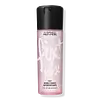Mac Cosmetics Prep + Prime Fix+ Makeup Setting Spray Versus Charlotte Tilbury Airbrush Flawless Setting Spray
What's inside
What's inside
 Key Ingredients
Key Ingredients

 Benefits
Benefits

 Concerns
Concerns

 Ingredients Side-by-side
Ingredients Side-by-side

Water
Skin ConditioningGlycerin
HumectantButylene Glycol
HumectantCucumis Sativus Fruit Extract
EmollientChamomilla Recutita Extract
Skin ConditioningCamellia Sinensis Leaf Extract
AntimicrobialRosa Damascena Flower Water
MaskingTocopheryl Acetate
AntioxidantCaffeine
Skin ConditioningPanthenol
Skin ConditioningArginine
MaskingCaprylyl Glycol
EmollientPEG-40 Hydrogenated Castor Oil
EmulsifyingPPG-26-Buteth-26
Skin ConditioningCitronellol
PerfumingGeraniol
PerfumingDisodium EDTA
Phenoxyethanol
PreservativeWater, Glycerin, Butylene Glycol, Cucumis Sativus Fruit Extract, Chamomilla Recutita Extract, Camellia Sinensis Leaf Extract, Rosa Damascena Flower Water, Tocopheryl Acetate, Caffeine, Panthenol, Arginine, Caprylyl Glycol, PEG-40 Hydrogenated Castor Oil, PPG-26-Buteth-26, Citronellol, Geraniol, Disodium EDTA, Phenoxyethanol
Water
Skin ConditioningAmp-Acrylates/Allyl Methacrylate Copolymer
Pvp
Emulsion StabilisingPhenoxyethanol
PreservativePentylene Glycol
Skin ConditioningPropanediol
SolventPolysorbate 20
EmulsifyingCitric Acid
BufferingEthylhexylglycerin
Skin ConditioningAloe Barbadensis Leaf Juice Powder
Skin ConditioningParfum
MaskingPotassium Sorbate
PreservativeGlycerin
HumectantCaprylic/Capric Triglyceride
MaskingCamellia Oleifera Leaf Extract
AstringentPistacia Lentiscus Gum
MaskingHydrogenated Lecithin
EmulsifyingLeuconostoc/Radish Root Ferment Filtrate
AntimicrobialPhenethyl Alcohol
MaskingWater, Amp-Acrylates/Allyl Methacrylate Copolymer, Pvp, Phenoxyethanol, Pentylene Glycol, Propanediol, Polysorbate 20, Citric Acid, Ethylhexylglycerin, Aloe Barbadensis Leaf Juice Powder, Parfum, Potassium Sorbate, Glycerin, Caprylic/Capric Triglyceride, Camellia Oleifera Leaf Extract, Pistacia Lentiscus Gum, Hydrogenated Lecithin, Leuconostoc/Radish Root Ferment Filtrate, Phenethyl Alcohol
 Reviews
Reviews

Ingredients Explained
These ingredients are found in both products.
Ingredients higher up in an ingredient list are typically present in a larger amount.
Glycerin is already naturally found in your skin. It helps moisturize and protect your skin.
A study from 2016 found glycerin to be more effective as a humectant than AHAs and hyaluronic acid.
As a humectant, it helps the skin stay hydrated by pulling moisture to your skin. The low molecular weight of glycerin allows it to pull moisture into the deeper layers of your skin.
Hydrated skin improves your skin barrier; Your skin barrier helps protect against irritants and bacteria.
Glycerin has also been found to have antimicrobial and antiviral properties. Due to these properties, glycerin is often used in wound and burn treatments.
In cosmetics, glycerin is usually derived from plants such as soybean or palm. However, it can also be sourced from animals, such as tallow or animal fat.
This ingredient is organic, colorless, odorless, and non-toxic.
Glycerin is the name for this ingredient in American English. British English uses Glycerol/Glycerine.
Learn more about GlycerinPhenoxyethanol is a preservative that has germicide, antimicrobial, and aromatic properties. Studies show that phenoxyethanol can prevent microbial growth. By itself, it has a scent that is similar to that of a rose.
It's often used in formulations along with Caprylyl Glycol to preserve the shelf life of products.
Water. It's the most common cosmetic ingredient of all. You'll usually see it at the top of ingredient lists, meaning that it makes up the largest part of the product.
So why is it so popular? Water most often acts as a solvent - this means that it helps dissolve other ingredients into the formulation.
You'll also recognize water as that liquid we all need to stay alive. If you see this, drink a glass of water. Stay hydrated!
Learn more about Water